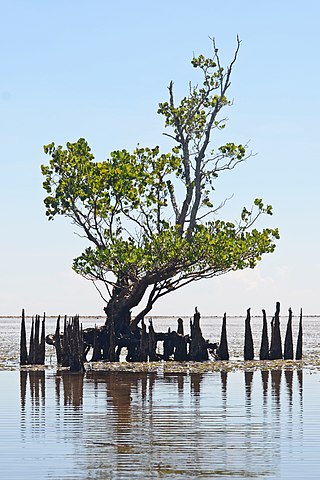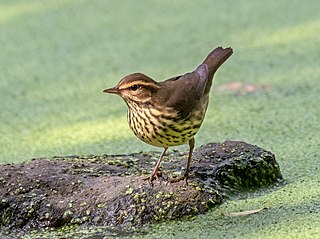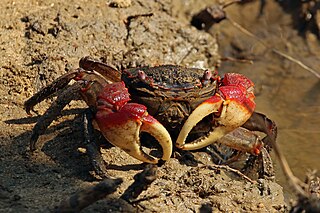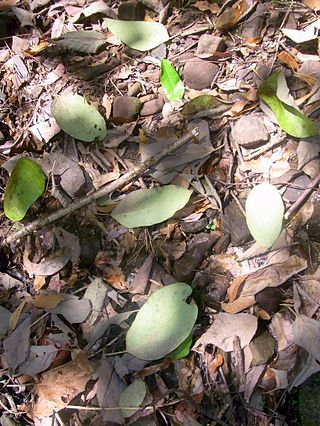
A mangrove is a shrub or tree that grows mainly in coastal saline or brackish water. Mangroves grow in an equatorial climate, typically along coastlines and tidal rivers. They have special adaptations to take in extra oxygen and to remove salt, which allow them to tolerate conditions that would kill most plants. The term is also used for tropical coastal vegetation consisting of such species. Mangroves are taxonomically diverse, as a result of convergent evolution in several plant families. They occur worldwide in the tropics and subtropics and even some temperate coastal areas, mainly between latitudes 30° N and 30° S, with the greatest mangrove area within 5° of the equator. Mangrove plant families first appeared during the Late Cretaceous to Paleocene epochs, and became widely distributed in part due to the movement of tectonic plates. The oldest known fossils of mangrove palm date to 75 million years ago.

Copepods are a group of small crustaceans found in nearly every freshwater and saltwater habitat. Some species are planktonic, some are benthic, a number of species have parasitic phases, and some continental species may live in limnoterrestrial habitats and other wet terrestrial places, such as swamps, under leaf fall in wet forests, bogs, springs, ephemeral ponds, puddles, damp moss, or water-filled recesses of plants (phytotelmata) such as bromeliads and pitcher plants. Many live underground in marine and freshwater caves, sinkholes, or stream beds. Copepods are sometimes used as biodiversity indicators.

The northern waterthrush is a species of ground-feeding migratory New World warbler of the genus Parkesia. It breeds in the northern part of North America in Canada and the northern United States including Alaska, and winters in Central America, the West Indies and Florida, as well as in Venezuela, Colombia, and Ecuador. It is a rare vagrant to other South American countries and to western Europe. Its closest relative is the Louisiana waterthrush.

Mangrove crabs are crabs that live in and around mangroves. They belong to many different species and families and have been shown to be ecologically significant by burying and consuming leaf litter. Mangrove crabs have a variety of phylogenies because mangrove crab is an umbrella term that encompasses many species of crabs. Two of the most common families are sesarmid and fiddler crabs. They are omnivorous and are predated on by a variety of mammals and fish. They are distributed widely throughout the globe on coasts where mangroves are located. Mangrove crabs have wide variety of ecological and biogeochemical impacts due to the biofilms that live in symbiosis with them as well as their burrowing habits. Like many other crustaceans, they are also a human food source and have been impacted by humans as well as climate change.

Harpacticoida is an order of copepods, in the subphylum Crustacea. This order comprises 463 genera and about 3,000 species; its members are benthic copepods found throughout the world in the marine environment and in fresh water. A few of them are planktonic or live in association with other organisms. Harpacticoida represents the second-largest meiofaunal group in marine sediments, after nematodes. In Arctic and Antarctic seas, Harpacticoida are common inhabitants of sea ice. The name Harpacticoida comes from the Greek noun harpacticon and the suffix -oid and means reminiscent of a predator.

The family Argulidae, whose members are commonly known as carp lice or fish lice, are parasitic crustaceans in the class Ichthyostraca. It is the only family in the monotypic subclass Branchiura and the order Arguloida, although a second family, Dipteropeltidae, has been proposed. Although they are thought to be primitive forms, they have no fossil record.

Mangrove forests, also called mangrove swamps, mangrove thickets or mangals, are productive wetlands that occur in coastal intertidal zones. Mangrove forests grow mainly at tropical and subtropical latitudes because mangroves cannot withstand freezing temperatures. There are about 80 different species of mangroves, all of which grow in areas with low-oxygen soil, where slow-moving waters allow fine sediments to accumulate.

Phytotelma is a small water-filled cavity in a terrestrial plant. The water accumulated within these plants may serve as the habitat for associated fauna and flora.
Leptocaris is a genus of copepods in the family Darcythompsoniidae. One species, the Mexican endemic L. stromatolicolus, is included on the IUCN Red List as a vulnerable species. The genus contains the following species:

Parasesarma pictum is a mudflat crab, belonging to the Sesarmidae family, which is endemic to East Asia. This crab typically inhabits mangrove swamps, preferring the upper intertidal region of estuaries, and living in small crevices and abandoned holes made by other species. It eats leaf litter and other vegetation. The breeding season of P. pictum is between May and September.

Plant litter is dead plant material that have fallen to the ground. This detritus or dead organic material and its constituent nutrients are added to the top layer of soil, commonly known as the litter layer or O horizon. Litter is an important factor in ecosystem dynamics, as it is indicative of ecological productivity and may be useful in predicting regional nutrient cycling and soil fertility.

Gelyella is a genus of freshwater copepods which are "surrounded by mystery". They live in groundwater in karstic areas of southern France and western Switzerland. The two species are the only members of the family Gelyellidae and, although previously placed in the order Harpacticoida, a new order, Gelyelloida, was erected for this family alone.

Melampus coffea, commonly known as the coffee bean snail, is a species of small air-breathing salt marsh snail, a pulmonate gastropod mollusk in the family Ellobiidae.
Parastenocarididae is a family of copepods in the order Harpacticoida adapted to life in groundwater. It contains the following genera:
Dioithona oculata is a species of small crustacean, a marine copepod in the order Cyclopoida. It is native to the Indo-Pacific region but has spread to other parts of the world. It is a free-swimming epipelagic species found near the surface of the water. It was first described as Oithona oculata by the Irish zoologist George Philip Farran in 1913.
Acartia tonsa is a species of marine copepod in the family Acartiidae.

Tigriopus brevicornis is a coastal marine copepod. They are a dominant member of shallow supra tidal rock pools along the North Western European coastline. A broad range of studies have been carried out on this species, including: its ecology, physiology, phylogeography, metapopulation genetics, development and reproductive behaviour. T. brevicornis has also recently been used in ecotoxicology studies and has been trialled as a live feed for larvae in several aquaculture-based studies for the past 30 years.

The clade Multicrustacea constitutes the largest superclass of crustaceans, containing approximately four-fifths of all described crustacean species, including crabs, lobsters, crayfish, shrimp, krill, prawns, woodlice, barnacles, copepods, amphipods, mantis shrimp and others. The largest branch of multicrustacea is the class Malacostraca.
Longipedia is a genus of marine copepods of the family Longipediidae, order Canuelloida.













